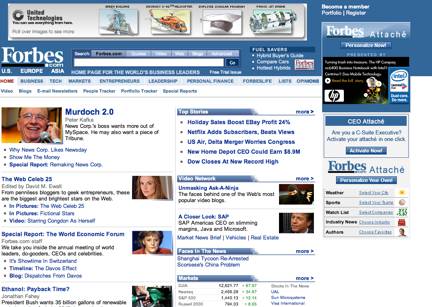Mequoda views Internet Hubs as one of the most important website archetypes available to a publisher. Without a well-designed, well-marketed Internet Hub, an online publisher is forced to rely on other websites and other media to drive targeted website traffic.
An Internet Hub is very robust, offering tons of useful information for free. It is designed to maximize online advertising inventory. State-of-the-art Internet Hubs offer users email newsletters, blogs, email alerts and RSS feeds that are all designed to directly and indirectly generate more page views and website revenue.
Internet Hubs generate value from both the users and the sponsors. The user pays with time and information. They spend time viewing web pages, emails and RSS feeds thus creating advertising inventory that can be used to sell the publisher’s products and/or that can be sold to third party sponsors.

Without a well-designed, well-marketed Internet Hub, an online publisher is forced to rely on other websites and other media to drive targeted website traffic. In most cases, this dramatically increases the cost of doing business online and thus limits online revenue generation in total and as a percentage of total media brand revenue.
[text_ad]
A handful of large media brands like Consumer Reports succeed without a formal Internet Hub by partnering with large portals like Yahoo! and AOL in a content-for-traffic deal. We would argue that even Consumer Reports, with its stellar online track record, could further improve its online performance by launching its own Internet Hub.
Most publishers do not have the luxury of outsourcing traffic generation to their Internet Hubs to websites owned by other media and therefore do not enjoy Consumer Reports’ level of online success—which we will discuss later on in this report.
Key Concepts
Business Goals: As the media brand nexus, the Internet Hub is designed to maximize online advertising inventory. To do that, the most successful Internet Hubs use conditional information architecture to treat registered and unregistered users differently.
For the unregistered user, a significant potion of the website page template is allocated to converting visitors into registered users.
Once a user has registered, the Internet Hub morphs to display content that is personalized for the user. Personalized content enhances user satisfaction and increases page views and time spent—the key advertising conversion rates that drive website revenue for the many information marketers who use their advertising inventory to sell their own products.
State-of-the-art Internet Hubs offer users email newsletters, blogs, email alerts and RSS feeds that are all designed to directly and indirectly generate more page views and website revenue.
User Goals: The Internet Hub target user is passionate about the special-interest topic or topics covered by the Hub. They may initially encounter the Internet Hub through any of 31 documented sources of targeted website traffic including:
-
- organic and paid search engine results,
- links from other websites,
- email passed along by a registered user,
- paid ads or earned mentions in other media (magazines, newspapers, books, TV, trade shows, etc…) or
- buzz (aka: old fashion word of mouth from friends and colleagues).
Revenue Model: Internet Hubs generate value from both the users and the sponsors. The user pays, not with money (all website content is free), but with time and information. They spend time viewing web pages, emails and RSS feeds thus creating advertising inventory that can be used to sell the publisher’s products (internal advertising) and/or that can be sold to third party sponsors (external advertising) on a CPM (Cost per Thousand), CPC (Cost per Click) or CPA (Cost per Action) basis.
Key Metrics: Top line revenue for an Internet Hub can be reported and forecasted by one of two simple models that avoid digging down into the morass of website metrics:
To maximize advertising to sell Publisher-branded products:
(Average Registered Users) times (Revenue per Registered User) will be a reliable reporting and forecasting method for websites that primarily monetize their advertising inventory (web, email and RSS) using internal advertising (advertising that sells the publisher’s branded products).
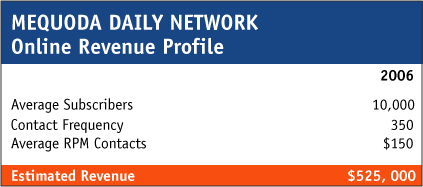
To maximize advertising to sell products from third party sponsors:
(Average Impressions) times (Revenue per M Impressions) will be a reliable reporting and forecasting method for websites that primarily monetize their advertising inventory (web, email and RSS) using external advertising (advertising that sells or promotes products from third party sponsors that is sold on a CPM, CPC or CPA basis).
Many media websites now incorporate rich content (audio, video and interactive applications) that keeps readers on page for long durations—thus allowing multiple advertisements to rotate through a single page view during the user’s stay.
Third party reporting systems like Alexa, Compete SnapShot, comScore Media Metrix, and Nielsen Net Ratings count simple page views. The publisher’s advertising server, in contrast, will report advertisements served. Thus if a user stays on one rich media page for three minutes and the advertising server displays a new advertisement every 30 seconds, one page view will generate three advertising impressions—thus tripling the revenue generated per page view. Revenue per page view would also be much higher for websites that stream online video where one page view could include a 10-minute video program that includes three 60-second commercials. All this makes estimating a publisher’s online revenue using third party traffic data a challenging exercise. In the end, only the publisher can truly know their revenue per page view.
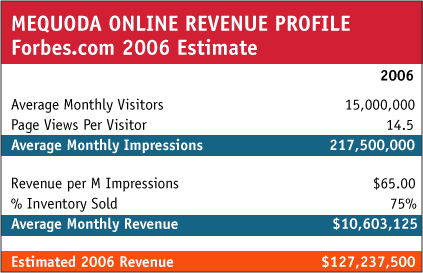
Content: Successful Internet Hubs use both publisher-generated content and user-generated content to build out their websites.
- Editorial Hubs: We refer to an Internet Hub that relies primarily on publisher-generated content with some to zero user content as an Editorial Hub (USA Today, Forbes, Epicurious).
- Social Hubs: An Internet Hub that relies primarily on user-generated content is often referred to as a Social Hub (MySpace, FaceBook, YouTube).
- Blog Hubs: Other popular Internet Hubs use a Blog (Web Log) content management system to create a blended mix of publisher and user-generated content. We call these Blog Hubs (TMZ, Engadget and The Huffington Post).
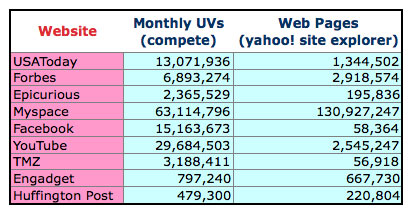
Social Hubs can become very large very quickly and draw millions of unique monthly users with little or no marketing spending. The low quality of the content, however, results in very low Revenue per M impressions—one of the two key metrics for Internet Hubs that rely on external advertising sponsors for revenue generation. Editorial Hubs take longer to build and currently generate the highest revenue per M (RPM) page views. Blog Hubs offer a mix of the two content strategies and generate mid-range RPM page views. We predict that as more publishing brands launch Blog Hubs and independent Blog Hubs gain credibility by forming blog publishing networks, their RPM page views, emails sent and RSS page views will rise to match the Editorial Hubs in their niche. We do not currently see the same trend for Social Hubs in terms of sponsorship value.
Navigation: Successful Editorial Hubs and Blog Hubs have a topic-based navigation system that relies on topic pages, content tags, recency, and user ratings to help users find the information they seek. Appropriate information architecture will allow users to find the content they seek by browsing more than 80 percent of the time. Usability studies have shown that users who locate content by browsing rate the site as faster than users who resort to an internal search engine to find content. Further, users who successfully browse through content they want are six-times more likely to make a purchase than users who search.
Social Hubs have a member-based navigation system that relies on member attributes to find the content (member) they desire.
Based on the importance of the Internet Hub, we’ve reviewed 15 different Internet Hub websites that are each associated with a unique media brand: Forbes.com, MySpace, USA Today, The Daily Reckoning, Linked In, Better Homes & Gardens, Engadget, Daily Word, FaceBook, Playboy, America’s Test Kitchen, Epicurious, InfoWorld, Johns Hopkins Health Alerts, and HR Daily Advisor, to illustrate various aspects of Internet Hub user functionality and information architecture.
Forbes.com
America’s Most Popular Magazine Website Leads with Publisher Content
Forbes.com was America’s most popular magazine website from January through December 2006 with between 6.9 and 12.5 million unique visitors per month. Yahoo! Site Explorer reports that Forbes.com includes more than 2 million editorial pages and almost 2.5 million inbound links. According to CEO Jim Spanfeller, his team posts more than 1,000 new stories everyday—including 100 percent of the content from the Forbes twice-monthly magazine. This Mequoda best practice Editorial Hub features an easy-to-navigate interface, frequently updated multi-media content and a best in class email alert system. Our estimates indicate that Forbes.com revenue exceeded $120 million for 2006—a 65 percent increase over 2005.
MySpace
America’s #1 Social Network Lets the Users Generate the Content
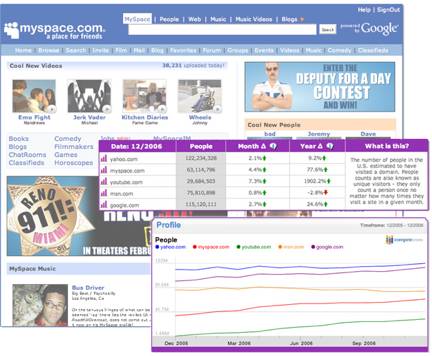
MySpace.com topped 63 million unique U.S. visitors in December 2006 and continues to climb. Unique visitors have almost doubled during 2006 as the site’s army of users continues to build more and more web pages. As of January 6, 2007, Yahoo! Site Explorer reports that MySpace includes more than 132 million web pages with more than 32 million inbound links. The loyal MySpace users generate content and then drive traffic to it. MySpace continues to draw in low CPM and relatively low click rates for the Google CPC ads. Still, what it lacks in quality, it makes up for in quantity and low operating costs.
USA Today
America’s #1 Newspaper Website Uses Surveys to Earn Media Attention
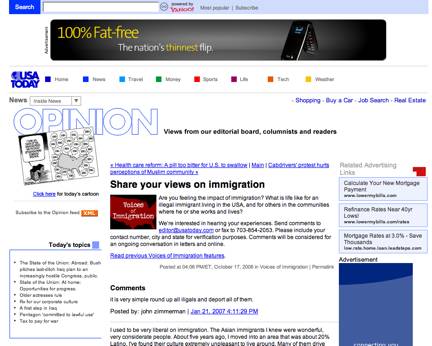
With more than 10.3 million inbound links to just 1.3 million pages on their site, it is easy to understand how USA Today’s 13.1 million unique U.S. visitors went to their site in December 2006. One link building strategy that serves this publisher well is its constant online surveys and the steady stream of proprietary factoids they produce. When we checked the website one day in January, we found valuable homepage real estate leading to the page above.
The Daily Reckoning
Generating Website Traffic the Old Fashion Way with Targeted Advertising

These gifted direct marketers, Agora Financial Services, parent of The Daily Reckoning, know how to build email circulation. The Daily Reckoning Internet Hub is basically a series of Rapid Conversion Landing Pages that offer free reports and Sales Letter Landing Pages that offer paid products and free subscriptions to The Daily Reckoning. A little ugly, the Editorial Hub is best in class at converting visitors who deep link to landing pages by clicking on text ads. With just 5,044 pages of content, the site has attracted 157,278 inbound links.
While the site averages only 50,000 unique U.S. visitors to its Internet Hub, The Agora Financial Network includes more than 135 dedicated subscription marketing and product marketing websites with unique URLs. Senior executives tells us that The Daily Reckoning remains steady at just over 500,000 email subscribers and Mequoda estimates subscribers spend upwards of $80 per year on Agora information products. $40 million in annual online revenue revenues is an impressive figure—it is even more impressive when you discover it is only one of the seven Internet Hubs that the company operates domestically.
Better Homes & Gardens
America’s Top Home Service Magazine Offers Five Free Email Newsletters
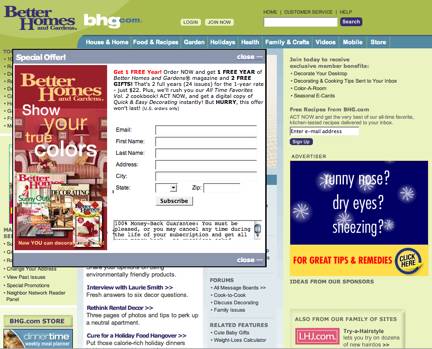
In 2006, sources tell us bhg.com will generate more than 600,000 net paid subscriptions for the print magazine and its sister magazines. With 2006 website traffic fluctuating wildly between 2.26 million and 4.76 million unique U.S. visitors according to Compete, the direct marketers at Meredith Corporation believe that driving email circulation and driving print circulation for the brand go hand-in-hand. According to Yahoo! Site Explorer, the site has just over 351,000 pages with about 345,000 inbound links. Meredith invented both Order Forms in Editorial (OFIEs) and Floater Order Forms (interstitial ads that appear to float on top of the web page) that dramatically increase conversion rates for any publisher who tests them.
Engadget
America’s Top Independent Blog Wants You to Take Their RSS Feed

With unique U.S. website visitors ranging from a low of 526,000 to a high of 949,000 over the past 12 months, Engadget is America’s most popular independent media blog. The site relies on 31 RSS feeds to generate targeted advertising inventory in the user’s RSS reader and back home at engadget.com. Engadget offers its users 636,028 pages of content in January 2007 and a very impressive 2.8 million inbound links. Online publisher Weblogs, Inc. publishes 12 additional target blogs on a variety of topics that use the same website architecture and business model.
Facebook
As Facebook Offers More Network Options, Traffic Continues to Grow
With more than 15 million unique U.S. visitors in December 2006, Facebook.com visitors increased by 50 percent across 2006 according to Compete Snapshot. The social networking site relies on users to invite other users and buzz marketing to drive traffic—both virtually cost free traffic sources for this successful online publisher. While its unclear how many pages Facebook contains (most are behind the firewall and available only to registered users within a given social network such as a school or region) Yahoo! Site Explorer can find 2.3 million inbound links on the pages it can “see.

Playboy
Men’s Lifestyle Website is Old Hand at Online Publishing & Marketing
With between 2.1 and 2.5 million unique U.S. visitors per month over the past 12 months Playboy.com, the Editorial Hub for the Playboy Online Network relies heavily on its email marketing efforts to drive both traffic and direct sales of its products and membership websites. The main URL includes 64,688 findable pages (many more pages are behind the firewall accessible only to paid members) with 135,574 inbound links as of January 2007. Many sites in the larger Playboy Online Network are located at unique URLs, like www.playboystore.com.
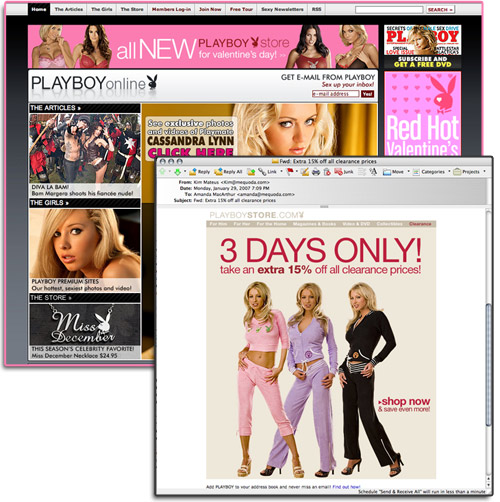
America’s Test Kitchen
The #1 PBS Cooking Show’s Website is Designed to Sell
Most publishers are familiar with Chris Kimball’s popular Public Broadcasting System (PBS) TV show, America’s Test Kitchen (ATK), and know there is a companion magazine called Cook’s Illustrated. But most have no idea about the breadth of the ATK brand or magnitude of its sustained growth in revenues and profits (From $15 to $46 million in annual revenue over just six years). There are in fact, two magazines (three-year-old Cook’s Country is the second), a series of best-selling books, multiple websites, three Mequoda-style Website Networks that include Editorial Hubs, Catalog and Subscription Retail Websites and a Membership Website for the Cook’s Illustrated brand, an email newsletter and DVDs.
All of these are part of a sophisticated, consumer-oriented network of products created by Boston Common Press, the quiet little company that owns the ATK brand. The ATK Network Hub (pictured above) includes just 858 pages that have attracted an impressive 14,614 inbound links according to Yahoo! Site Explorer. The ATK website has been seen by between 124,000 and 232,000 unique U.S visitors during 2006 according to Compete Snapshot—much lower than we would have expected for a website that is constantly promoted as the #1 cooking show on PBS.
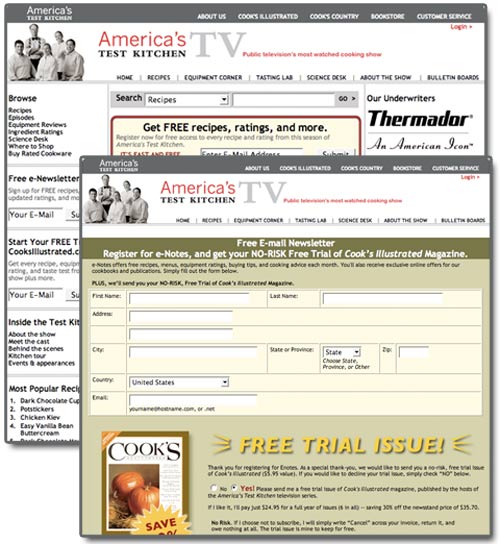
Epicurious
Conde Nast Creates a New Brand to Create Online Advertising Inventory
With more than 155,000 web pages and 331,000 inbound links, Epicurious.com is one of a handful of websites owned by a traditional media organization that is a top 1000 website (Compete Rank #609—December 2006). With unique U.S. visitors topping two million in December 2006, the Epicurious team is on a roll with a dramatically upgraded and more user friendly website. The treasure trove of recipes from Bon Appetit and Gourmet is offered to readers via the website, email and RSS feed. Advertising is topical—Kenmore, Best Buy, Splenda, Bailey’s, plus joint ventures with iGourmet.com, and Jessica’s Biscuit® (ecookbooks.com). In addition to driving traffic to third-party sponsors, this Editorial Hub also supports its own online classified directory, which drives traffic to a variety of third-party retail websites.
InfoWorld
Leading B2B Publisher Experiments with Full Content RSS Feeds with Sponsors
While most online publishers still use RSS (Real Simple Syndication) as a way to drive users back to the website to view the full story, some publishers are offering users full content via RSS with display and/or text advertising. Although InfoWorld offers many RSS feeds, our analysis only uncovered one that offers users full content and display advertising. Over the past few weeks, we’ve seen HP and IDC (an IDG sister company) running display advertising units in the InfoWorld Top News RSS Feed.
Over the years, InfoWorld has been the most edgy of the IDG, USA websites, which also include Computerworld, Network World, PC World and MacWorld. With more than 880,000 pages of content and 3.3 million inbound links, the InfoWorld site dwarfs many consumer magazine sites in its size and scope. Compete Snapshot reports that InfoWorld has increased its audience by 53 percent during 2006 to 132,139 unique monthly U.S. visitors.
Johns Hopkins Health Alerts
University Health Publishing Goes Online in 2006

Johns Hopkins Health Alerts is a Blog Hub that is the nexus of the new Johns Hopkins Health Network which includes 31 retail subscription and retail product websites accessible via the Johns Hopkins Bookstore home page. The website’s information architecture is based on 15 health topics. Content for each topic can be accessed freely via the website, RSS feed or email newsletter. Registered users are offered the opportunity to buy Johns Hopkins periodicals, white papers and books via website advertising, email newsletter advertising and solo email promotions. The newly launched website network (May 2006) generated more than 40,000 unique U.S. website visitors in November 2006—a 4X increase from its May launch according to Compete Snapshot. With a mere 449 pages of website content, the new site has already attracted more than 10,000 inbound links (Yahoo! Site Explorer).
HR Daily Advisor
Building Online Relationships with HR Professionals

HR Daily Advisor is the B2B Blog Hub for the BLR HR Network—which includes HR.BLR.com, a best practice Membership Website, and BLR.com, an HR superstore with hundreds of B2B information products. The BLR Network includes 124,444 web pages with more than 12,000 inbound links. The HR Daily Advisor information architecture is based on 11 topics that are used to categorize website and email content. One hundred percent of HR Daily Advisor’s advertising inventory is used to promote BLR products. The BLR Network averaged between 100,000 and 165,000 U.S. unique monthly visitors according to Compete.
This article was written by Don Nicholas with the help of Peter A. Schaible. It is only one part of a series on Internet Business Models. See below for the rest of this series:
